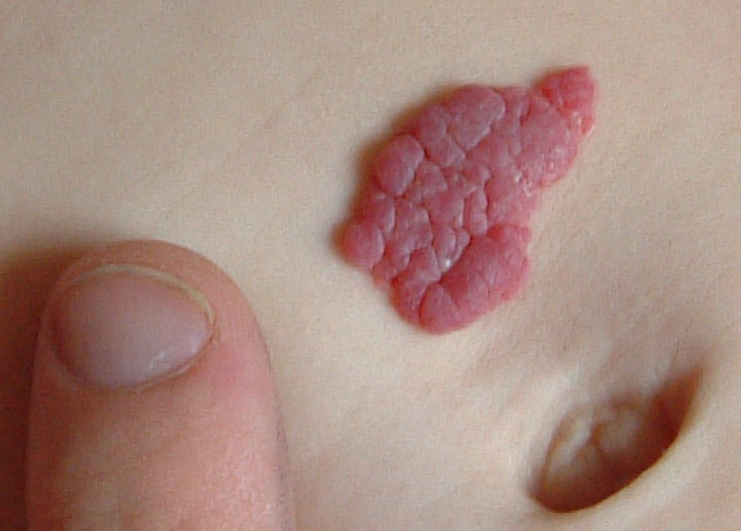What are the symptoms of strawberry hemangiomas?
Strawberry hemangiomas, also known as infantile hemangiomas, are benign growths of blood vessels that often appear in infants. They are called “strawberry” hemangiomas because of their red color and slightly raised appearance, resembling a strawberry. The symptoms include:
- Bright Red Bump: The most common feature is a raised, bright red area on the skin, typically appearing within the first few weeks of life. The color results from the concentration of blood vessels within the hemangioma.
- Soft and Raised Texture: Strawberry hemangiomas are often soft to the touch and may feel spongy. They are usually raised above the skin’s surface.
- Rapid Growth: In the first few months, these hemangiomas may grow quickly, becoming larger or more prominent.
- Common Locations: They frequently occur on the face, scalp, chest, or back, but they can appear anywhere on the body.
- Gradual Fading: After reaching their maximum size, hemangiomas usually stop growing and start to fade over time. They often shrink and become less noticeable as the child grows, typically starting around 1 year of age.
- Potential Ulceration or Bleeding: In some cases, especially if the hemangioma is in a high-friction area, the surface may break down, leading to ulceration, irritation, or bleeding.
Most strawberry hemangiomas are harmless and do not require treatment. They often resolve on their own by the time the child is 5 to 10 years old. However, if the hemangioma interferes with vital functions (such as vision or breathing), or if it becomes ulcerated or infected, medical evaluation and treatment may be necessary.
What are the causes of strawberry hemangiomas?
Strawberry hemangiomas, or infantile hemangiomas, are caused by an abnormal growth of blood vessels. While the exact cause is not fully understood, several factors contribute to their development:
- Abnormal Blood Vessel Development: Strawberry hemangiomas are formed from an unusual buildup of small blood vessels. These vessels multiply more than usual in a localized area, creating the red, raised appearance.
- Genetic Factors: Although hemangiomas are not directly inherited, there may be a genetic component that increases the likelihood of their occurrence. Certain families may have a higher incidence of hemangiomas.
- Premature Birth: Premature infants, especially those born before 37 weeks of gestation, are at higher risk of developing hemangiomas. This suggests that the condition may be linked to the development of blood vessels during gestation.
- Low Birth Weight: Babies with low birth weight, particularly those under 2.2 pounds (1 kg), are more likely to develop strawberry hemangiomas.
- Female Gender: Girls are more likely to develop hemangiomas than boys. The reason for this gender difference is not entirely clear.
- Multiple Births: Twins and other multiples have a higher incidence of hemangiomas compared to single births.
The exact trigger for why these factors lead to hemangiomas is still being researched. However, most strawberry hemangiomas are benign, resolve on their own over time, and are not linked to any serious underlying health issues.
What is the treatment for strawberry hemangiomas?
Most strawberry hemangiomas do not require treatment and tend to resolve on their own over time. However, treatment may be necessary if the hemangioma interferes with vital functions, causes complications, or leads to significant cosmetic concerns. Treatment options include:
- Observation: In many cases, the best approach is to monitor the hemangioma. These growths often grow rapidly in the first few months of life, then stabilize, and eventually shrink. By age 5 to 10, many hemangiomas have faded or disappeared entirely.
- Beta-Blockers (Oral or Topical): Propranolol, a beta-blocker, is often the first-line treatment for problematic hemangiomas. It can be taken orally and works by shrinking the blood vessels in the hemangioma. Topical beta-blockers (like timolol) may be used for smaller or superficial hemangiomas.
- Corticosteroids: In cases where beta-blockers are not effective or appropriate, corticosteroids may be used. They can be administered orally, injected directly into the hemangioma, or applied topically to reduce growth.
- Laser Therapy: Laser treatments can be used to remove or reduce the size of hemangiomas, especially if they are causing complications, like ulceration, or are cosmetically concerning.
- Surgery: In rare cases where the hemangioma is large, obstructing vital functions (such as vision or breathing), or not responding to other treatments, surgical removal may be considered. This is typically done after the growth phase, once the hemangioma has stabilized.
- Wound Care for Ulcerated Hemangiomas: If the hemangioma develops an open sore (ulcer), wound care management may be necessary to prevent infection and promote healing. This might involve dressings, topical treatments, and close monitoring.
The choice of treatment depends on factors such as the location, size, growth pattern, and whether the hemangioma is causing functional issues. An early consultation with a pediatric dermatologist or specialist is recommended if treatment is being considered.

Leave a Reply
You must be logged in to post a comment.